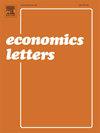Calculating effective degrees of freedom for forecast combinations and ensemble models
IF 2.1
4区 经济学
Q2 ECONOMICS
引用次数: 0
Abstract
Forecast combinations, also known as ensemble models, routinely require practitioners to select a model from a massive number of potential candidates. Ten explanatory variables can be grouped into forecast combinations, and the number of possibilities increases further to if we allow for forecast combinations of forecast combinations. This paper derives a calculation for the effective degrees of freedom of a forecast combination under a set of general conditions for linear models. It also supports this calculation with simulations. The result allows users to perform several other computations, including the F-test and various information criteria. These computations are particularly useful when there are too many candidate models to evaluate out of sample. Furthermore, computing effective degrees of freedom shows that the complexity cost of a forecast combination is driven by the parameters in the weighting scheme and the weighted average of parameters in the auxiliary models as opposed to the number of auxiliary models. This identification of complexity cost contributions can help practitioners make informed choices about forecast combination design.
求助全文
约1分钟内获得全文
求助全文
来源期刊

Economics Letters
ECONOMICS-
CiteScore
3.20
自引率
5.00%
发文量
348
审稿时长
30 days
期刊介绍:
Many economists today are concerned by the proliferation of journals and the concomitant labyrinth of research to be conquered in order to reach the specific information they require. To combat this tendency, Economics Letters has been conceived and designed outside the realm of the traditional economics journal. As a Letters Journal, it consists of concise communications (letters) that provide a means of rapid and efficient dissemination of new results, models and methods in all fields of economic research.
 求助内容:
求助内容: 应助结果提醒方式:
应助结果提醒方式:


